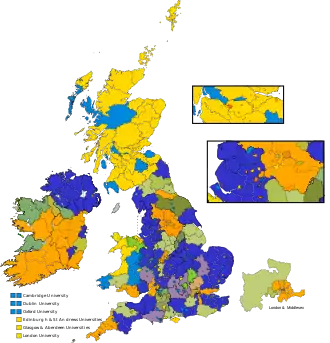| ||||||||||||||||||||||||||||||||||
All 658 seats in the House of Commons 327 seats needed for a majority | ||||||||||||||||||||||||||||||||||
|---|---|---|---|---|---|---|---|---|---|---|---|---|---|---|---|---|---|---|---|---|---|---|---|---|---|---|---|---|---|---|---|---|---|---|
| ||||||||||||||||||||||||||||||||||
 Colours denote the winning party | ||||||||||||||||||||||||||||||||||
| ||||||||||||||||||||||||||||||||||
The 1868 United Kingdom general election was the first after passage of the Reform Act 1867, which enfranchised many male householders, thus greatly increasing the number of men who could vote in elections in the United Kingdom. It was the first election held in the United Kingdom in which more than a million votes were cast; nearly triple the number of votes were cast compared to the previous election in 1865.
The Liberals, led by William Gladstone, increased their majority over Benjamin Disraeli's Conservatives again to more than 100 seats.
This was the last general election at which all seats were taken by only the two leading parties, although the parties at the time were loose coalitions and party affiliation was not listed on registration papers.
Results

| UK General Election 1868 | |||||||||||||||
|---|---|---|---|---|---|---|---|---|---|---|---|---|---|---|---|
| Party | Candidates | Votes | |||||||||||||
| Stood | Elected | Gained | Unseated | Net | % of total | % | No. | Net % | |||||||
| Liberal | 600 | 387 | +18 | 58.81 | 61.24 | 1,428,776 | +2.0 | ||||||||
| Conservative | 436 | 271 | −18 | 41.19 | 38.71 | 903,318 | −2.1 | ||||||||
| Others | 3 | 0 | 0 | 0 | 0 | 0 | 0.05 | 1,157 | N/A | ||||||
Voting summary
Seats summary
Regional results
Great Britain
| Party | Candidates | Unopposed | Seats | Seats change | Votes | % | % change | |
|---|---|---|---|---|---|---|---|---|
| Liberal | 515 | 80 | 321 | 1,374,315 | 61.4 | |||
| Conservative | 383 | 65 | 234 | 864,551 | 38.6 | |||
| Other | 1 | 0 | 0 | 969 | 0.0 | |||
| Total | 899 | 145 | 555 | 2,239,835 | 100 | |||
England
| Party | Candidates | Unopposed | Seats | Seats change | Votes | % | % change | |
|---|---|---|---|---|---|---|---|---|
| Liberal | 412 | 46 | 244 | 1,192,098 | 59.7 | |||
| Conservative | 334 | 54 | 211 | 803,637 | 40.2 | |||
| Other | 1 | 0 | 0 | 969 | 0.1 | |||
| Total | 747 | 100 | 455 | 1,996,704 | 100 | |||
Scotland
| Party | Candidates | Unopposed | Seats | Seats change | Votes | % | % change | |
|---|---|---|---|---|---|---|---|---|
| Liberal | 70 | 23 | 51 | 125,356 | 82.5 | |||
| Conservative | 20 | 3 | 7 | 23,985 | 17.5 | |||
| Total | 90 | 26 | 58 | 149,341 | 100 | |||
Wales
| Party | Candidates | Unopposed | Seats | Seats change | Votes | % | % change | |
|---|---|---|---|---|---|---|---|---|
| Liberal | 29 | 10 | 23 | 52,256 | 62.1 | |||
| Conservative | 20 | 4 | 10 | 29,866 | 37.9 | |||
| Total | 49 | 14 | 33 | 82,122 | 100 | |||
Ireland
| Party | Candidates | Unopposed | Seats | Seats change | Votes | % | % change | |
|---|---|---|---|---|---|---|---|---|
| Liberal | 85 | 41 | 66 | 54,461 | 57.9 | +2.3 | ||
| Irish Conservative | 53 | 26 | 37 | 38,765 | 41.9 | |||
| Other | 2 | 0 | 0 | 188 | 0.2 | +0.2 | ||
| Total | 140 | 67 | 103 | 149,341 | 100 | |||
Universities
| Party | Candidates | Unopposed | Seats | Seats change | Votes | % | % change | |
|---|---|---|---|---|---|---|---|---|
| Conservative | 9 | 4 | 6 | 7,063 | 55.4 | |||
| Liberal | 4 | 1 | 3 | 4,605 | 44.6 | |||
| Total | 13 | 5 | 9 | 11,668 | 100 | |||
See also
References and further reading
- Craig, F. W. S. (1989), British Electoral Facts: 1832–1987, Dartmouth: Gower, ISBN 0900178302
- Rallings, Colin; Thrasher, Michael, eds. (2000), British Electoral Facts 1832–1999, Ashgate Publishing Ltd
- Roberts, Matthew (2013). "Election Cartoons and Political Communication In Victorian England". Cultural and Social History. 10 (3): 369–395. doi:10.2752/147800413X13661166397229. S2CID 143879878. (covers 1860 to 1890).

.jpg.webp)